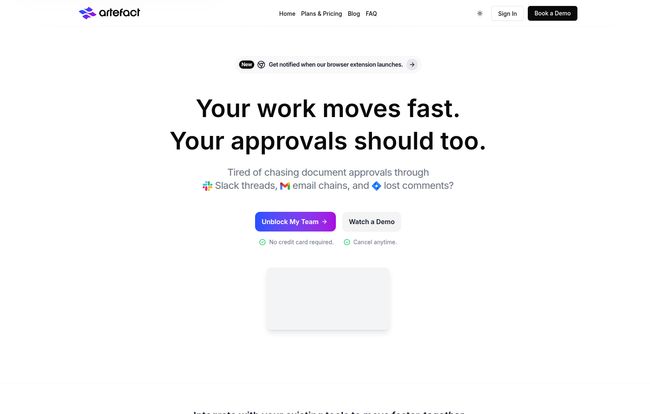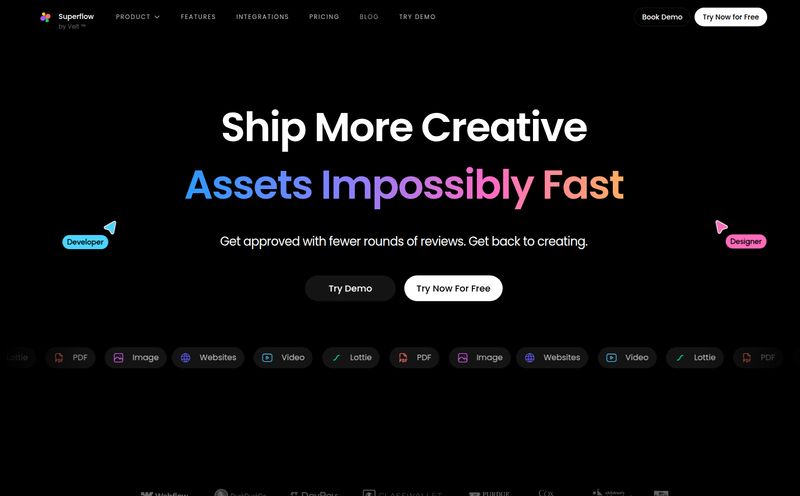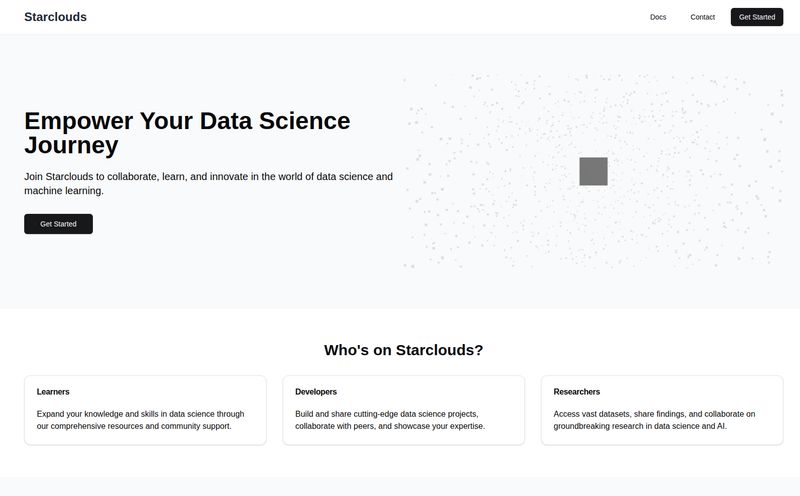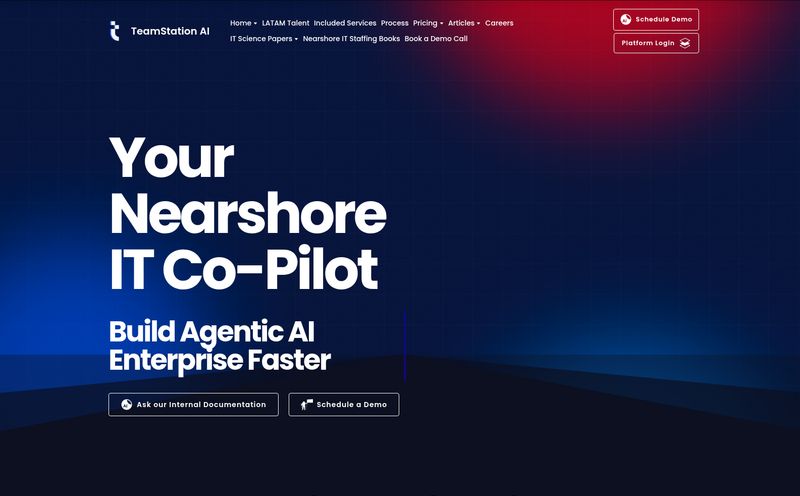If you’ve worked in tech for more than a week, you’ve lived through some version of documentation hell. You know the one. You spend days, maybe weeks, crafting the perfect Product Requirements Document (PRD) or technical spec. It’s a masterpiece. You send it out for approval to stakeholders in engineering, product, marketing, and legal. And then… silence.
Crickets. Tumbleweeds. You start nudging people on Slack. You send polite-but-firm follow-up emails. You feel less like a project leader and more like a professional cat-herder. I remember one project where we lost a full sprint cycle—two whole weeks!—just waiting for three different department heads to sign off on a doc. By the time they did, half the requirements were already outdated. It was… frustrating, to put it mildly.
This whole song and dance is so common it's basically a meme in the industry. So when a tool comes along that claims its whole reason for being is to fix this exact problem, my ears perk up. Enter Artefact, an AI-powered platform that wants to turn your documentation bottleneck into an engine for moving faster.
But we’ve heard these promises before, right? So, does it actually work, or is it just another layer of complexity? Let's get into it.
So What is Artefact, Really?
On the surface, Artefact is an AI platform for technical documentation. But that’s a bit like calling a smartphone a pocket calculator. The real magic isn’t just about writing docs. It’s about what happens after you write them.
Instead of forcing you to migrate your entire life to a new, walled-garden platform (looking at you, a dozen other SaaS tools I’ve abandoned), Artefact cleverly layers itself on top of what you already use: Google Workspace. It integrates directly with your Docs, Sheets, and Slides. This is huge. It means adoption isn't this massive, painful change management project. You connect your workspace, install a browser extension, and you’re basically off to the races.
Its core mission is to streamline, track, and automate the entire approval process. Think of it as mission control for the paper trail that drives your projects.
The Features That Genuinely Got My Attention
A feature list is just a list. What matters is whether those features solve a real, throbbing pain point. Here’s what stood out to me from Artefact’s offering.
The Magic is in the Workflow Automation
This is the big one. Artefact lets you build structured approval flows directly within your document environment. No more manually tagging people and hoping they see it. You can define who needs to approve what, and in what order. When one person signs off, it automatically gets routed to the next person in the chain. It’s like setting up a domino rally, but instead of falling blocks, it’s productive approvals.
With a single click, start assigning reviewers through the extension.
The dashboard gives you a bird's-eye view of where every document is in its lifecycle. You can see what's moving, what's stuck, and who the bottleneck is. This isn’t about calling people out; it’s about having the data to see where your process is breaking down. Maybe Dave in Legal is always the hold-up. Not because Dave is slow, but because he's swamped. This insight lets you have a real conversation about resources, not just send another passive-aggressive “just bumping this” email.

Visit Artefact
An AI Writing Partner That Stays in its Lane
Okay, let's talk about the AI. In 2024, if your SaaS tool doesn't have an AI component, does it even exist? ArtefactAI is their writing assistant. It helps with the usual suspects: improving clarity, fixing grammar, and ensuring consistency. But what's more interesting is its ability to help enforce org-wide standards. It can analyze your docs in real-time to make sure they're aligning with your team’s established best practices.
This is a far cry from the “AI will write all your docs for you” fantasy. It's a practical co-pilot. It handles the tedious stuff so your human experts can focus on the actual substance. And frankly, that's where AI is most useful right now—as a smart assistant, not a replacement for critical thought.
Show Me the Money (Savings)
On their pricing page, Artefact has a projected cost savings calculator. I’m usually super skeptical of these things. They can feel like pure marketing fluff. But this one at least tries to ground itself in reality. It bases its calculations on your team size and average salary, factoring in time saved from hunting for information and waiting on approvals. It estimates a 47% efficiency gain from information retrieval alone, citing their own research.
Is that number exact? Probably not. But does it illustrate a real point? Absolutely. The time wasted on disorganization has a very real cost. Seeing it quantified, even as an estimate, is a powerful nudge for any manager trying to justify a new tool.
Let's Talk About the Price Tag
So, what does this organizational nirvana cost? Artefact’s pricing is thankfully straightforward, which is a breath of fresh air. They have a three-tiered approach that seems to make sense for different kinds of teams.
| Plan | Price | Best For |
|---|---|---|
| Starter | Free | Individuals or small teams just getting started and wanting to try out the core features with unlimited members. |
| Growth | $10 per team member / month | Growing teams that feel the pain of documentation bottlenecks and need advanced features like approval history and team assignments. |
| Enterprise | Custom | Large organizations that need SSO, advanced security, dedicated support, and custom onboarding. |
My take? The Free plan is genuinely useful. It's not one of those crippled free tiers that's just a constant upsell. You get the core workflow automation for unlimited members, which is incredibly generous. For any team curious about fixing their process, it’s a no-brainer to start here.
The Growth plan at $10/user/month feels very reasonable. If your team has even one or two highly-paid engineers or managers being held up by documentation chaos, this tool pays for itself almost instantly. It's aimed squarely at teams that have moved past the 'is this a problem?' stage and are now at the 'we must fix this now' stage.
The Good, The Not-So-Bad, and The Considerations
No tool is perfect. After spending time with Artefact, I see a lot to love, but also a few things to keep in mind. It's definitely a net positive, especially because it streamlines a process that is currently a mess of emails, Slack messages, and hope. The AI assistance is a nice-to-have, but the real star is the workflow automation that brings clarity to the chaos of approvals. Plus, the insights dashboard can finally give you data to back up that gut feeling that your documentation process is horribly inefficient.
However, once you move to the paid tier, the cost could be a consideration for very small startups or bootstrapped teams where every dollar counts. Also, like any new tool, it requires some change in behavior—you have to get your team to actually use the extension. And then there's the philosophical point about AI. Some might worry that leaning too much on AI for checking standards could reduce deep, critical human review. I personally think that's a bit of a stretch—it’s an assistant, not an autocrat—but it's a valid thought to have in teh back of your mind.
So, Who is This Really For?
I think Artefact hits a sweet spot. If you're a solo freelancer, this is probably overkill. If you're a small, tight-knit team of three that sits next to each other, you can probably get by with a tap on the shoulder.
But if you are a Product Manager trying to get sign-off from multiple departments, an Engineering Lead tired of ambiguous specs, or a CTO looking to standardize processes across a growing organization… this could be your new best friend. It’s for any team that has felt the tangible pain of a project stalling because a crucial document is lost in someone’s inbox.
Frequently Asked Questions About Artefact
- 1. What is Artefact in simple terms?
- Think of it as an intelligent management layer for your Google Docs and Sheets. It doesn't replace them, but it adds powerful workflow automation on top to make sure documents get reviewed and approved by the right people, fast.
- 2. How does Artefact integrate with my existing tools?
- It connects directly to your Google Workspace account. The main interface for users is a simple browser extension that works inside the Google Docs, Sheets, and Slides you already use every day. Onboarding is designed to be quick and painless.
- 3. Is Artefact's AI going to write my technical docs for me?
- No, and that's a good thing. The ArtefactAI is more of a co-pilot or an intelligent assistant. It helps you write better and faster by improving clarity, checking for consistency, and making sure you're following your team's established standards, but the core ideas and expertise still come from you.
- 4. What kind of teams benefit most from using Artefact?
- Cross-functional teams in tech companies are the prime audience. Product, engineering, design, and marketing teams that collaborate on complex documents (like PRDs, RFCs, technical specs) and struggle with slow, manual approval processes will see the most immediate benefit.
- 5. Is the Free 'Starter' plan actually useful?
- Yes, surprisingly so. It allows for unlimited members and includes the core features of document routing and automated notifications. It's a fantastic way to prove the tool's value to your team before committing to a paid plan.
- 6. How does the pricing work for the Growth plan?
- The Growth plan is priced at $10 per team member, per month. You are billed for each person on your team who is actively part of your Artefact workspace, which gives them access to all the advanced features.
My Final Verdict on Artefact
Look, I've seen a ton of tools that promise to revolutionize productivity. Most of them fall flat. Artefact, however, feels different. It's not trying to reinvent the wheel. It's just adding a motor and a GPS to it.
By focusing on a single, universally painful problem—the document approval bottleneck—and integrating with the tools we're all already stuck with, they've created something genuinely useful. It’s not a magic wand that will instantly fix all your company’s communication issues, but it is a powerful step in the right direction.
If you're tired of chasing signatures and want to get back to doing the real work, giving Artefact’s free plan a spin seems like one of the easiest, and potentially most impactful, decisions you could make this quarter.



